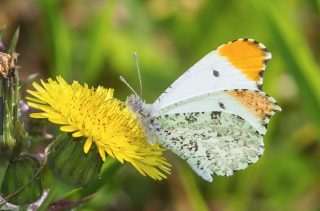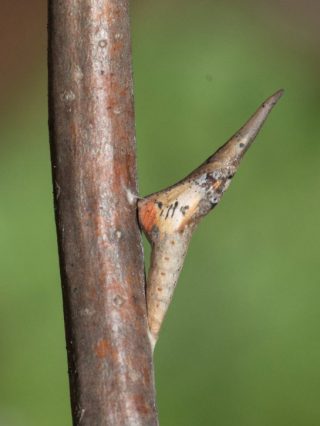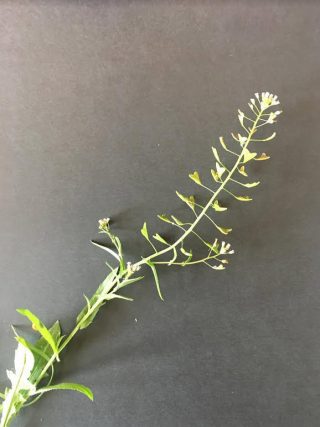
The Falcate Orangetip is a special denizen of the Brush Country. This butterfly has only one mating flight per year, in the early spring. Greg Lasley photo.
Searching for a Special Denizen of the Brush – Karen L. P. Benson
It is March and time for a special Brush Country species to be showing up: The Falcate Orangetip.
What’s a Falcate Orangetip, you ask? It is a butterfly: a pretty, white butterfly. Falcate Orangetips are one of the first signs of spring. Throughout their range, the Orangetips emerge early, fly around briefly, mate and lay eggs, and die. It is up to the eggs to hatch and carry on the life of this species.
One flight per year; that is all the Falcate Orangetips have. Many butterfly species have several flights, with several generations per season. Monarchs, for instance, have four to six broods per year. But the Orangetips have only one brood per year and they start it in the early spring.
Which is why for the past few weeks, I have been looking for the males patrolling the edges of the brush. On every sunny day, around mid-day, I drive the buggy slowly along the trails through our patch of the Brush Country. I scan the thorny scrub for signs of butterfly movement. I have scared up many a grasshopper, dragonfly, and bee. Butterfly movement is different, with wings flapping more or less lazily. I have seen Red Admirals, Bordered Patches, and Pipevine Swallowtails, all on the prowl. These three are dark in color, so I refine my search-image: I must look only for white or whitish butterflies. Immediately, I spot a low flying whitish butterfly. But it is tiny, only about a half an inch across. It cannot be an Orangetip; they are at least an inch and a half across.

When the Falcate Orangetip larvae pupate, they make a unique chrysalis. It resembles a thorn on a Brush Country plant! Alabama Butterfly Atlas photo.
I refine my search-image again. I must look for rather large, whitish butterflies. I spot one! I follow it with my eyes and then my binoculars. It lands on a low growing plant. I see that its closed wings are slightly greenish. Not an Orangetip but instead it is a Lyside Sulphur. Well, at least I am finally getting butterflies in the right family! Orangetips belong to the Pieridae Family (the Whites and Sulphurs) so I am on the right track.
Eventually, I spot a white butterfly of the correct size. It flies swiftly up and over the top of the brush before I can get a good look at it. Did it have front wings with a hooked (falcate) edge? Did it have an orange spot near the point? I could not tell. The one that got away was my best candidate for a Falcate Orangetip.
A few days later, I see another white butterfly. This has to be one ! But, uh-oh, no orange spot. However, I suddenly remember that the female Orangetips do NOT have orange tips! This was very likely a female Falcate Orangetip.
Still, if the females are flying then most likely I have missed the main flight of the males. The males emerge up to two weeks ahead of the females. They patrol the brush searching for the females just as they emerge from their chrysalises. The males need to mate with the females at their most receptive. By the time that most females are flying around looking for suitable host plants on which to lay their eggs, they have already mated. The males have done their job and are beginning to die off.
The females lay their eggs singly on individual plants. The caterpillars feed mostly on flowers, buds and seedpods. Since the caterpillars are also cannibalistic, it is a good thing to have only one caterpillar per host plant. The caterpillars feed on rock cress, winter cress, Shepherd’s Purse and possibly on a few other host plants in the Mustard Family. The pupae (chrysalises) of Falcate Orangetips are fascinating. They resemble a thorn! This is very appropriate camouflage in the Brush Country. The butterflies overwinter as chrysalids, sometimes for up to two years. I wonder if this is why I have seen so few Orangetips this spring. Maybe they have decided to remain in the pupal state for an extra year.

The host plants for Falcate Orangetip are in the Mustard Family. Rock Cresses and Shepherd’s Purse are typical plants used by this species. Shepherd’s Purse is named for the shape of its seedpods. Shepherds were known to make purses from the scrotum of a sheep. Karen Benson photo.
Even if I have missed the main flight of these delicate butterflies, I plan to keep looking for a few more days. Perhaps I will see an Orangetip nectaring on one of our wild mustard plants. Orangetips also visit violets for nectar, in habitats that support violets (probably not south Texas!) Hopefully, I will get lucky…if not there is always next spring.
